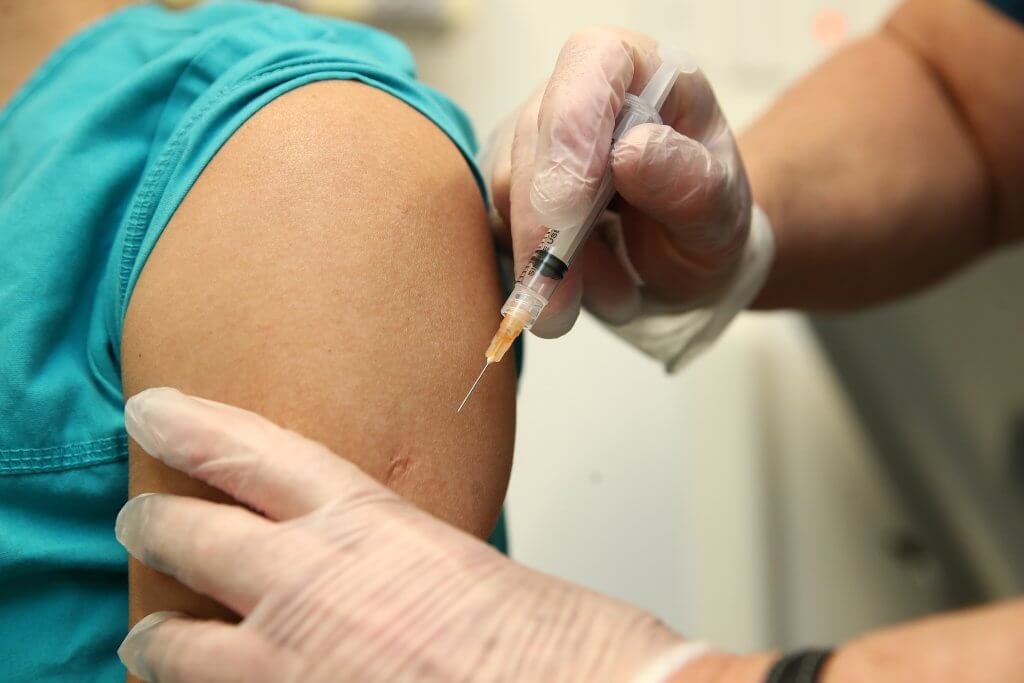Hogan Enlists Guard Units, Retired Health Professionals to Help Vaccinate Marylanders

Fighting off complaints that Maryland has been slow to act, Gov. Lawrence J. Hogan Jr. (R) pledged on Tuesday that the state will use “every single resource” it has to get as many people vaccinated against COVID-19 as quickly as possible.
But he urged residents to be patient as the state, local health departments, hospitals and chain pharmacies undertake a massive vaccine distribution effort that he called “the greatest peacetime undertaking in American history.”
According to a Bloomberg tracker, Maryland has used 26.5% of the doses it has received, putting it firmly in the middle of the pack. (South Dakota has used 64.5% of its supply; Kansas just 15.3%.)
Speaking to reporters, Hogan said under-reporting by hospitals and national drug store chains CVS and Walgreens make the numbers appear worse than they are. The companies have federal contracts to vaccinate nursing home residents and staff.
Hogan said he spoke with the CEOs of both firms on Tuesday and urged them to work more quickly — and he issued an executive order requiring the companies to report vaccinations within 24 hours. Under their contract with the federal Department of Health and Human Services, they have 72 hours.
In the first three weeks of the state’s vaccination campaign, 270,150 doses have been distributed to hospitals, local health departments and pharmacies, Hogan said, representing 98.7% of Maryland’s allocation from the federal government.
Like other states, Maryland is in Phase 1A of its rollout, targeting local first-responders, health care workers, corrections personnel, judiciary staff and vulnerable populations.
The governor said “some hospitals are doing extremely well” while others are “still just ramping up.” One facility has used just 16% of its vaccines, while another has already used two-thirds.
“While none of us are thrilled with the pace of this rollout over the first couple of weeks, I can assure you that it is improving every day,” Hogan said. On Monday, 11,553 people were vaccinated, the most for a single day, bringing the total to 76,916.
Under a new order from the state Department of Health, any provider that hasn’t administered at least 75% of their first-dose allocation may have future shipments reduced and sent elsewhere — “until they can prove their ability to meet capacity requirements,” the governor said.
“I want to assure the people of Maryland that we are going to leverage every single resource at our disposal to get more shots into more arms as quickly as we possibly can, in a safe and orderly way.”
Beginning on Wednesday, the Maryland National Guard will dispatch emergency support teams to assist local health departments with their vaccination clinics. The Guard will assist with administering vaccines and provide logistical support.
Hogan also announced that 700 volunteers — many of them recently retired medical professionals — will begin helping local health departments.
The governor said the state expects to move from Phase 1A to 1B at the end of January— and he announced that 1B has been expanded to include all Marylanders over the age of 75, teachers, child care and education staff, special needs group homes, high-risk inmates, people with developmental disabilities and “continuity of government.”
Phases 1A and 1B constitute an estimated 1.36 million Marylanders.
The new Phase 1C now includes all Marylanders age 65 to 74 as well as people who work in grocery stores, public transit operations, agriculture production and manufacturing. Based on the current pace of allocation, the state expects to enter Phase 1C, a group estimated at 772,000 residents, by early March.
Although the Maryland Democratic Party criticized the state’s vaccine rollout in a press release this week, Hogan struck a largely positive tone throughout his remarks, saying the state is looking to help speed the vaccination campaign, not place blame.
He dismissed suggestions that local health departments have received conflicting guidance from the state. “That’s completely not true,” he said.
Local officials “can whine about it or they can get to work and do their job.”
Hogan said five counties — Howard, Montgomery, St. Mary’s, Calvert and Caroline — had done an exemplary job standing up vaccination programs.
Baltimore City and Prince George’s County are “very far behind” in their vaccination efforts, “but we’re going to try to provide ‘em every bit of help we can. If we have to send in the National Guard to help them, we’re going to be there.”




 Creative Commons Attribution
Creative Commons Attribution